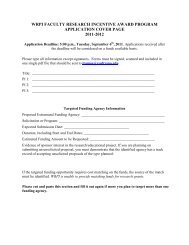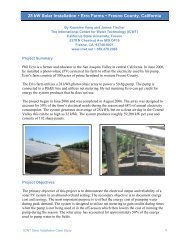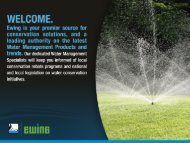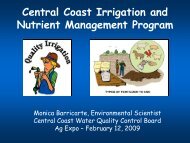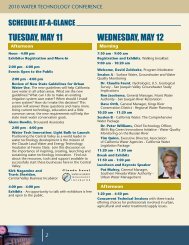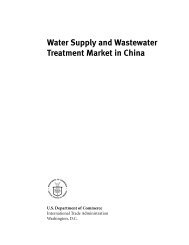Collaborative Research on the Future of Groundwater ... - ICWT
Collaborative Research on the Future of Groundwater ... - ICWT
Collaborative Research on the Future of Groundwater ... - ICWT
Create successful ePaper yourself
Turn your PDF publications into a flip-book with our unique Google optimized e-Paper software.
<str<strong>on</strong>g>Collaborative</str<strong>on</strong>g> <str<strong>on</strong>g>Research</str<strong>on</strong>g> <strong>on</strong> <strong>the</strong> <strong>Future</strong> <strong>of</strong><br />
<strong>Groundwater</strong> Resources in California<br />
Jean E. Moran (California State University East Bay)<br />
in collaborati<strong>on</strong> with<br />
Lawrence Livermore Nati<strong>on</strong>al Laboratory and<br />
<strong>the</strong> State Water Resources C<strong>on</strong>trol Board GAMA Program
From Sierran to Central Valley and Coastal Basins
We know what happens when extracti<strong>on</strong><br />
exceeds recharge for decades
<strong>Groundwater</strong> banking science needs<br />
• Identificati<strong>on</strong> <strong>of</strong> suitable areas<br />
for groundwater banking<br />
• Determinati<strong>on</strong> <strong>of</strong> travel times<br />
for banking <strong>of</strong> recycled wastewater<br />
• Identificati<strong>on</strong> <strong>of</strong> recharged water<br />
to establish ownership<br />
• Understanding water quality<br />
changes associated with banking <strong>of</strong><br />
high-quality surface water in <strong>the</strong><br />
subsurface<br />
• Understanding transport <strong>of</strong><br />
emerging c<strong>on</strong>taminants during<br />
groundwater recharge<br />
Natural age tracer<br />
<strong>Groundwater</strong> recharge can be tracked<br />
using natural & introduced tracers<br />
Introduced xen<strong>on</strong> tracer
Xen<strong>on</strong> Tracer Experiment<br />
200 m<br />
500 m<br />
Xen<strong>on</strong> tracer<br />
delivery line<br />
Temperature (C)<br />
11.00 16.00 21.00<br />
0<br />
Xen<strong>on</strong> depth pr<strong>of</strong>ile<br />
0.10 1.00 10.00 100.00<br />
0<br />
10<br />
10<br />
20<br />
30<br />
40<br />
20<br />
30<br />
40<br />
0<br />
7<br />
10<br />
50<br />
50<br />
60<br />
60
Deep Mixed Recharge Surface<br />
Documenting improvements in water quality<br />
during artificial recharge
Deep<br />
Mixed<br />
Recharge<br />
Surface<br />
Cauti<strong>on</strong>ary tale <strong>of</strong> Arsenic mobilizati<strong>on</strong>
Publicati<strong>on</strong>s
Tracers for groundwater banking<br />
Locati<strong>on</strong>s <strong>of</strong> noble gas tracers experiments<br />
• Noble gases are ideal<br />
groundwater tracers<br />
• Can generate detailed<br />
measurements <strong>of</strong><br />
groundwater movement<br />
• Determine groundwater<br />
velocity, dispersi<strong>on</strong>,<br />
with a large dynamic<br />
range<br />
• Safe, readily accepted,<br />
cost effective
High Certainty for Earlier Peak<br />
Streamflow<br />
From: Dettinger et al., 2004
Challenges in predicting effects <strong>of</strong><br />
climate change <strong>on</strong> groundwater<br />
• Recharge is str<strong>on</strong>gly influenced by changes in<br />
precipitati<strong>on</strong> amount, which is not as wellpredicted<br />
as temperatures<br />
– Small changes in precipitati<strong>on</strong> may result in large<br />
changes in recharge in semi-arid, arid climates<br />
• Downscaling is major issue for predicting GW<br />
resp<strong>on</strong>se<br />
• Wide range in subsurface residence times <strong>of</strong><br />
complicates resp<strong>on</strong>se <strong>of</strong> surface watergroundwater<br />
interacti<strong>on</strong><br />
• N<strong>on</strong>-climatic drivers exert large influence <strong>on</strong><br />
recharge and groundwater levels
C<strong>on</strong>necti<strong>on</strong>s between snowmelt and<br />
groundwater recharge are poorly understood<br />
When and where does<br />
recharge take place<br />
What is <strong>the</strong> residence<br />
time <strong>of</strong> groundwater<br />
<br />
<strong>Groundwater</strong> Age<br />
3<br />
H- 3 He, 4 He rad<br />
[after Domenico & Schwartz, 1990]<br />
Noble Gases<br />
Recharge Temperature<br />
Excess Air
Olympic Valley: 6 producti<strong>on</strong> wells, 22 m<strong>on</strong>itoring wells, 3<br />
stream flow gauges, 2 horiz<strong>on</strong>tal wells
<strong>Groundwater</strong> Ages - Cross Secti<strong>on</strong><br />
1. Shallow alluvial<br />
aquifer<br />
-Recent recharge<br />
2: Mixed bedrock and<br />
alluvial flow<br />
-Pre-modern<br />
comp<strong>on</strong>ent<br />
-Radiogenic 4 He<br />
4<br />
He-rad
Recharge temperatures reveal timing<br />
and locati<strong>on</strong> <strong>of</strong> recharge<br />
• RTs c<strong>on</strong>sistent<br />
with or slightly<br />
higher than<br />
MAATs<br />
• Mean RT (7.8C)<br />
matches m<strong>on</strong>thly<br />
mean air<br />
temperature for<br />
May (7.7C)<br />
• Under current<br />
c<strong>on</strong>diti<strong>on</strong>s, most<br />
recharge occurs<br />
during May-June
Findings: Recharge locati<strong>on</strong> and<br />
residence time<br />
• Recharge occurs <strong>on</strong> lower slopes <strong>of</strong> catchment<br />
– Recharge temperatures close to mean annual air<br />
temperature and higher than expected for direct<br />
infiltrati<strong>on</strong> <strong>of</strong> snowmelt<br />
– Low excess air – minimal recharge through<br />
fractured rock<br />
– d 13 C <strong>of</strong> DIC indicates exchange with soil gas CO 2<br />
• <strong>Groundwater</strong> (even deep groundwater) in<br />
upstream porti<strong>on</strong> <strong>of</strong> <strong>the</strong> basin is young
Effects <strong>of</strong> Climate Change<br />
Climate Change Scenarios<br />
• More precip as rain, extended<br />
period <strong>of</strong> run<strong>of</strong>f<br />
• Earlier run<strong>of</strong>f<br />
• More rain <strong>on</strong> snow events<br />
• More nights above freezing<br />
temp.<br />
• Less total precip<br />
Effect <strong>on</strong> Recharge and Discharge<br />
• More recharge, if precip rate is<br />
lower than current snowpack melt<br />
rate<br />
• Early decreased baseflow (fast<br />
drainage)<br />
• Increased overland flow, less<br />
recharge to alluvium<br />
• More saturati<strong>on</strong>-induced overland<br />
flow, less recharge<br />
• Less recharge, near immediate<br />
effect <strong>on</strong> GW availability and<br />
streamflow<br />
Effects will be immediate and drastic at Olympic Valley
Acknowledgements and Publicati<strong>on</strong>s<br />
• Squaw Valley Public Services District<br />
– Derrik Williams<br />
(Hydrometrics LLC)<br />
• Alameda County Water District (Mikel Halliwell)<br />
• Orange County Water District (Roy Hernd<strong>on</strong>)<br />
• Students:<br />
– C. Cox, C. Tulley, C. Bart<strong>on</strong>, G. Rhett, D. Meyer, H. Bigman , Elizabeth Derubeis, Marianne<br />
Holtz, Pamela Beitz<br />
• LLNL Labs:<br />
– Noble Gas Lab (D. Hilleg<strong>on</strong>ds, M. Sharp, A. Visser)<br />
• Moran, J.E., Esser, B.K., Hilleg<strong>on</strong>ds, D. Holtz, M., Roberts, S.K., Singlet<strong>on</strong>, M.J., Visser, A. (2011) Nitrate fate<br />
and transport in <strong>the</strong> Salinas Valley. LLNL-TR-484186, 38pp.<br />
•<br />
• O’Leary, D.R., Izbicki, J.A., Moran, J.E., Meeth, T., Nakagawa, B., Metzger, L.,<br />
• B<strong>on</strong>ds, C., Singlet<strong>on</strong>, M.J. (2011) Movement <strong>of</strong> Water Infiltrated from a Recharge<br />
• Basin to Wells. Ground Water doi: 10.1111/j.1745-6584.2011.00838.x.<br />
•<br />
• Singlet<strong>on</strong>, M.J. and Moran, J.E. (2010) Dissolved noble gas and isotopic tracers reveal vulnerability <strong>of</strong><br />
groundwater in a small, high elevati<strong>on</strong> catchment to predicted climate changes. Water Resources <str<strong>on</strong>g>Research</str<strong>on</strong>g><br />
doi: 10.1029/2009WR008718.<br />
•<br />
• McNab, W.W., Singlet<strong>on</strong>, M.J., Moran, J.E., Esser, B.K. (2009) I<strong>on</strong> exchange and trace element surface<br />
complexati<strong>on</strong> reacti<strong>on</strong>s associated with applied recharge <strong>of</strong> low-TDS water in <strong>the</strong> San Joaquin Valley,<br />
California. Applied Geochemistry, 24, 129-137.



